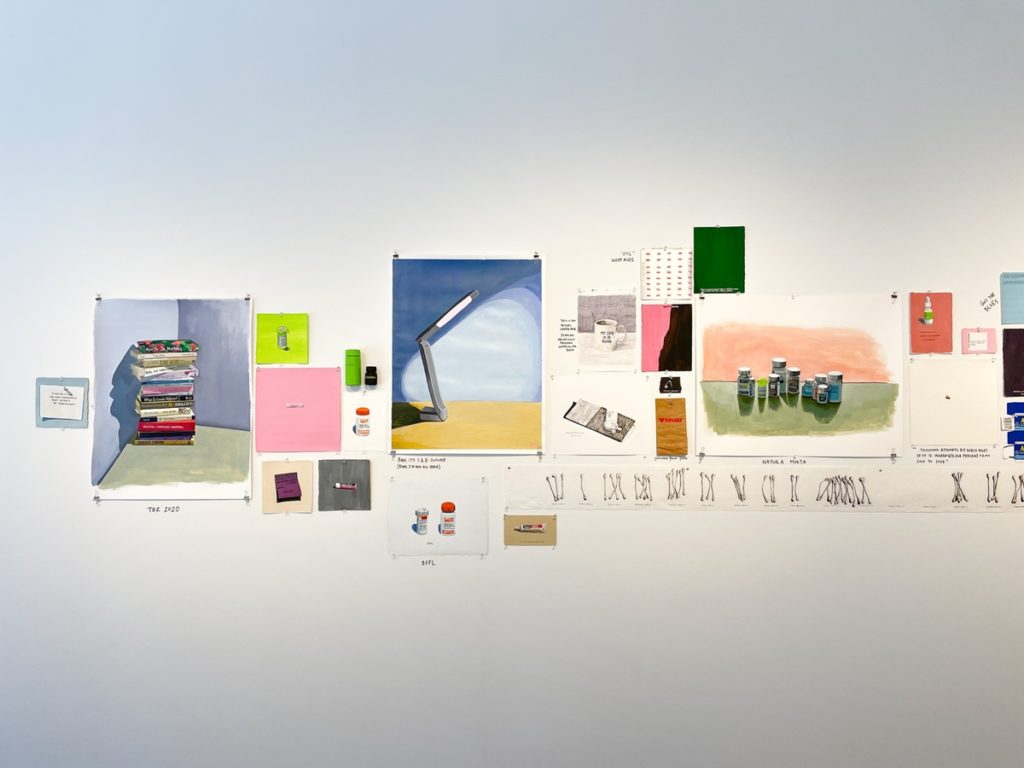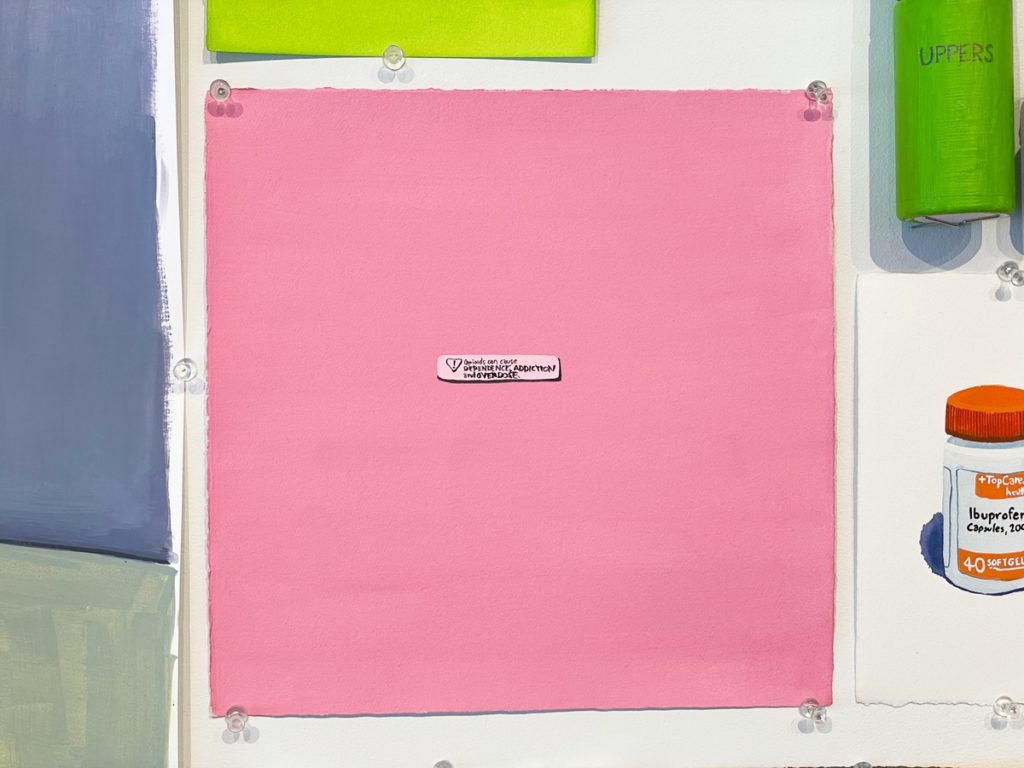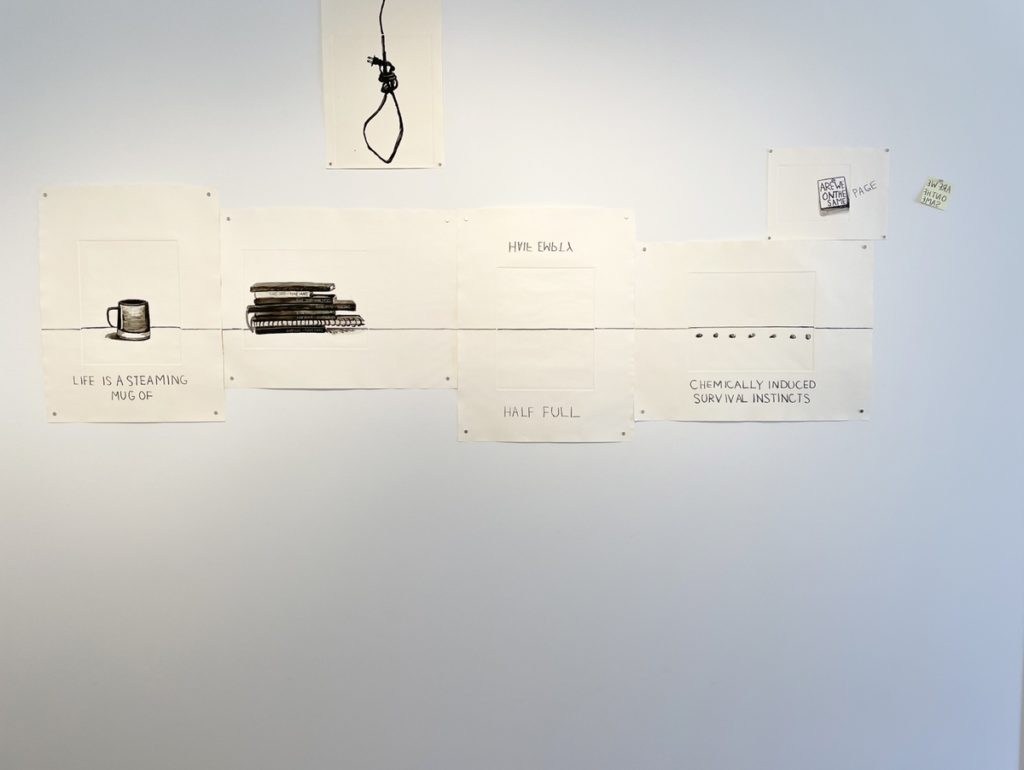Through the window of Centre(3), a row of illustrations in bright acrylic ink on Moleskine sketchbook paper could be seen at the back of the main gallery. An array of items – sunglasses, cough drops and pill bottles among them – tempted viewers to learn more.
at-home apothecary, or EXTRA STRENGTH + PAIN RELIEF, a mixed-media body of work that highlights themes of physical ailment, addiction and mental health, is as relevant in a semi-post-pandemic world as in 2016, when K. MacNeil (they/them) began creating the sketches that were displayed at Hamilton’s contemporary art gallery June 22-30.
When MacNeil began drawing their bedside pill bottles, it was a reaction to the personal struggles of finding things that they “use to cope.” The “vent sketches” were a place for MacNeil to come to grips with the colourful packaging meant to keep them “healthy and well.” The individual caricatures of brand-name medications stand alone as questions, asking the viewer if any of these things would truly help. Waste in the form of pill bottles and packaging become a direct criticism of the pharmaceutical industry.
Together, the pieces create the story of someone struggling to figure out what will help them live, from anti-depression lamps to self-help books to a healthy dose of Advil.
As I wandered through the exhibit, I had just finished a rotation in general surgery where much of my time was spent filling out admission sets and checking off boxes next to drug names. Staring at the painted ibuprofen packaging, I thought about every time I had messily ticked off ibuprofen 400mg; indication: pain.
When we prescribe to patients, it seems we expect them to have no issues filling prescriptions and taking their medication. Those who do are often labeled as non-adherent to therapy and branded as difficult. Yet looking at this exhibit, I was reminded that patients’ relationships with prescriptions and drugs is more complex.
The pursuit of wellness, or the ability to function in society, can easily become a cocktail of “chemically induced survival instincts”.
For some, there is a general distrust of the pharmaceutical industry, leading patients to avoid medications that could have therapeutic effects. For others, it may be the cost is unjustifiable or getting to the pharmacy is a journey in itself. Still others may fear possible side effects.
An illustration of a bright pink label reading “opioids may cause dependence, addiction and overdose” is a reminder of the systemic failure of the medical industry in treating chronic pain. A labelled pill bottle, simply called, “Brainmashers” in a cute pink, nods to the way those on antidepressants can make one feel emotionally blunted or detached. In a world where one in five people experience mental illness, the demand for access to mental health resources and psychiatrists continues to rise. It is a trial in itself to acquire a family doctor or a psychiatrist, yet for those prescribed medications, follow-up becomes just as difficult.
The exhibit also points to the fact that answers don’t solely lie in a new antidepressant lamp, “running more” or taking a solo drug regime. MacNeil advocates that “one size can’t fit all” in wellness. What it means to be well for a person may change over time and for them, is a “constant journey.”
A former marathon runner, the sticky-note saying “Run more” is more than a joke about the trend of wellness fitness runners. While running was a key part of MacNeil’s wellness routine, chronic pain became another barrier. The pursuit of wellness, or the ability to function in society, can easily become a cocktail of “chemically induced survival instincts”. at-home apothecary reflects an on-going journey that MacNeil and many others experience while searching for a way to cope and function despite physical and mental illness.
As prescribers of medication, physicians bridge the world between the pharmaceutical company and patients. Prescribing a drug may seem like paperwork to us but can have drastic effects on a patient’s life as access and reactions to medication can vary widely. Sometimes, medication is not always the solution to a patient’s problem and delving deeper into their presentation and social factors can help find a remedy more in line with their values and goals.
Either way, I know that after seeing this exhibit, next time I fill out an admission sheet, it will be a more conscious process.






The comments section is closed.